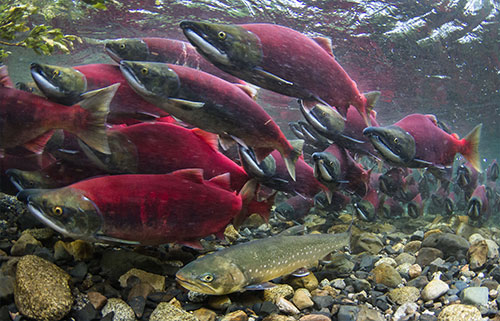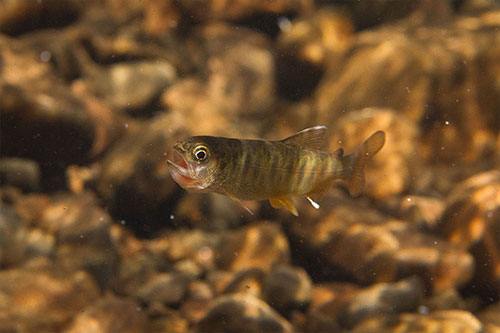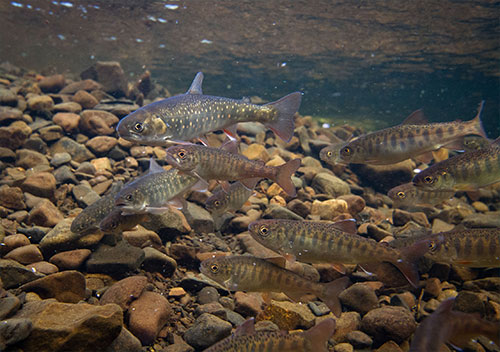
The Salmon StateThe impossible journey of the juvenile cohoStudy shows river systems behave like financial investments: diverse portfolios get better returnsBy MARY CATHARINE MARTIN
June 20, 2018
As a PhD student with the University of Washington’s Alaska Salmon Program, Jonny Armstrong — now assistant professor at Oregon State University’s Fish and Wildlife Department — snorkeled the Wood River in the Bristol Bay watershed. He soon encountered a mystery: juvenile coho as much as a mile from the nearest sockeye spawning ground had sockeye eggs in their stomachs.
Sockeye lay their eggs in cold water, where there’s lots of oxygen. A juvenile coho, however, doesn’t best digest sockeye eggs in that water — cold slows its digestion, meaning if it stayed there, it might need a week to process just one meal. “About every three days they’ll leave the warm water, swim downstream for an hour, get to where the sockeye are spawning, spend a couple hours there and go back the same night,” said Professor of Aquatic and Fisheries Sciences at UW Daniel Schindler, Armstrong’s then-advisor, who has researched salmon in the Bristol Bay area for more than 20 years. “This is a fish the size of your finger and it’s going two kilometers, or two miles even, in one day.” The importance of floodplain For two of Armstrong’s five years of research, the Wood River flooded, and its main channel was cold from top to bottom. So you’d think the coho wouldn’t grow as well in those years, right? “In the high water years we found coho basking in those (stagnant backwaters) that were dried up in the low water years,” Armstrong said.
The water had spilled over the river’s banks and onto the floodplain. On rainy years, that’s what warms up — meaning the coho didn’t even necessarily have to swim far away from their feeding grounds to find it. The message of that finding, Schindler said, is that “fish habitat looks different depending on what the hydrology is. If you have a stream like this, it allows it to continue functioning regardless of climate conditions…. To me, it’s a really important message for keeping floodplains of these rivers intact. It keeps options open for the fish to move around in.” In all years, the warmer water had another effect as well — coho there hatched up to two months earlier, meaning they were bigger come the sockeye run. In contrast, coho that hatched in colder areas couldn’t fit the sockeye eggs down their smaller throats, putting them further behind. Fish in warmer waters went to sea after just a year, sometimes, whereas those in colder water took two or three. Producing — and predicting — reliable salmon runs Through a technique developed by Sean Brennan, a PhD candidate at the University of Alaska Fairbanks, researchers have been able to map what rivers in the Bristol Bay system produce salmon in different years. That mapping shows that the entire Bristol Bay system — as well as salmon producers like the Yukon and the Kuskokwim — functions much like the smaller system of the Wood River: different rivers and tributaries produce more salmon in different years, depending on habitat conditions. A stream that didn’t produce much one year might produce a vast amount another year.
In other words, diversity of habitat is important to maintaining reliable salmon runs. “The term that we use is ‘portfolio,’ Schindler said. “The fish use this portfolio of habitat. What makes a fishery reliable is the entire portfolio of habitat diversity…. Systems are complex because moving water is moving around the habitat. If you prevent that, you’re going to simplify the river system. If you put roads into watersheds, what that does is prevent rivers from moving around and generating that habitat in the first place.” Scientists see the other extreme in places like the very developed Sacramento River, which produces incredibly unreliable salmon returns — sometimes in the hundreds of thousands, sometimes not enough to support any fishing at all. In high water years, because the watershed has been developed, juvenile salmon don’t have warmer, safer backwaters of a floodplain. Instead, they get flushed down the main channel. It’s for a similar reason that many people believe Oregon coho are now listed as threatened. Floodplain, Armstrong said, may be the most endangered kind of habitat in the world. “There are so few rivers,” he said, “that still have their natural oscillations and flows that maintain these floodplains.”
Representations of fact and opinions in comments posted are solely those of the individual posters and do not represent the opinions of Sitnews.
|
||||||


